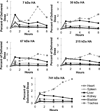Hyaluronic Acid Molecular Weight Determines Lung Clearance and Biodistribution after Instillation
- PMID: 27157508
- PMCID: PMC5200957
- DOI: 10.1021/acs.molpharmaceut.6b00069
Hyaluronic Acid Molecular Weight Determines Lung Clearance and Biodistribution after Instillation
Abstract
Hyaluronic acid (HA) has emerged as a versatile polymer for drug delivery. Multiple commercial products utilize HA, it can be obtained in a variety of molecular weights, and it offers chemical handles for cross-linkers, drugs, or imaging agents. Previous studies have investigated multiple administration routes, but the absorption, biodistribution, and pharmacokinetics of HA after delivery to the lung is relatively unknown. Here, pharmacokinetic parameters were investigated by delivering different molecular weights of HA (between 7 and 741 kDa) to the lungs of mice. HA was labeled with either a near-infrared dye or with iodine-125 conjugated to HA using a tyrosine linker. In initial studies, dye-labeled HA was instilled into the lungs and fluorescent images of organs were collected at 1, 8, and 24 h post administration. Data suggested longer lung persistence of higher molecular weight HA, but signal diminished for all molecular weights at 8 h. To better quantitate pharmacokinetic parameters, different molecular weights of iodine-125 labeled HA were instilled and organ radioactivity was determined after 1, 2, 4, 6, and 8 h. The data showed that, after instillation, the lungs contained the highest levels of HA, as expected, followed by the gastrointestinal tract. Smaller molecular weights of HA showed more rapid systemic distribution, while 67 and 215 kDa HA showed longer persistence in the lungs. Lung exposure appeared to be optimum in this size range due to the rapid absorption of <67 kDa HA and the poor lung penetration and mucociliary clearance of viscous solutions of HA > 215 kDa. The versatility of HA molecular weight and conjugation chemistries may, therefore, provide new opportunities to extend pulmonary drug exposure and potentially facilitate access to lymph nodes draining the pulmonary bed.
Keywords: biodistribution; haluronic acid; pharmacokinetics; pulmonary delivery; pulmonary transport; radiolabeled.
Figures







Similar articles
-
Tuned near infrared fluorescent hyaluronic acid conjugates for delivery to pancreatic cancer for intraoperative imaging.Theranostics. 2020 Feb 10;10(8):3413-3429. doi: 10.7150/thno.40688. eCollection 2020. Theranostics. 2020. PMID: 32206099 Free PMC article.
-
Use of radiolabeled hyaluronic acid for preclinical assessment of inflammatory injury and acute respiratory distress syndrome.Nucl Med Biol. 2022 Nov-Dec;114-115:86-98. doi: 10.1016/j.nucmedbio.2022.10.002. Epub 2022 Oct 14. Nucl Med Biol. 2022. PMID: 36270074 Free PMC article.
-
Biodistribution profiling of the chemical modified hyaluronic acid derivatives used for oral delivery system.Int J Biol Macromol. 2014 Mar;64:45-52. doi: 10.1016/j.ijbiomac.2013.11.027. Epub 2013 Dec 4. Int J Biol Macromol. 2014. PMID: 24315950
-
Hyaluronic acid : perspectives in lung diseases.Handb Exp Pharmacol. 2012;(207):385-401. doi: 10.1007/978-3-642-23056-1_17. Handb Exp Pharmacol. 2012. PMID: 22566234 Review.
-
In vivo, in vitro and ex vivo models to assess pulmonary absorption and disposition of inhaled therapeutics for systemic delivery.Adv Drug Deliv Rev. 2006 Oct 31;58(9-10):1030-60. doi: 10.1016/j.addr.2006.07.012. Epub 2006 Aug 15. Adv Drug Deliv Rev. 2006. PMID: 17010473 Review.
Cited by
-
Tuned near infrared fluorescent hyaluronic acid conjugates for delivery to pancreatic cancer for intraoperative imaging.Theranostics. 2020 Feb 10;10(8):3413-3429. doi: 10.7150/thno.40688. eCollection 2020. Theranostics. 2020. PMID: 32206099 Free PMC article.
-
Polymer Capsules with Hydrophobic Liquid Cores as Functional Nanocarriers.Polymers (Basel). 2020 Sep 2;12(9):1999. doi: 10.3390/polym12091999. Polymers (Basel). 2020. PMID: 32887444 Free PMC article. Review.
-
The role of hyaluronic acid and hyaluronidase-1 in obstructive sleep apnoea.Sci Rep. 2020 Nov 10;10(1):19484. doi: 10.1038/s41598-020-74769-4. Sci Rep. 2020. PMID: 33173090 Free PMC article.
-
Use of radiolabeled hyaluronic acid for preclinical assessment of inflammatory injury and acute respiratory distress syndrome.Nucl Med Biol. 2022 Nov-Dec;114-115:86-98. doi: 10.1016/j.nucmedbio.2022.10.002. Epub 2022 Oct 14. Nucl Med Biol. 2022. PMID: 36270074 Free PMC article.
-
An Effective Translation: The Development of Hyaluronan-Based Medical Products From the Physicochemical, and Preclinical Aspects.Front Bioeng Biotechnol. 2018 May 17;6:62. doi: 10.3389/fbioe.2018.00062. eCollection 2018. Front Bioeng Biotechnol. 2018. PMID: 29868577 Free PMC article. Review.
References
-
- Kuo JW. Practical Aspects of Hyaluronan Based Medical Products. Boca Raton, FL: CRC Press; 2006.
-
- Schanté CE, Zuber G, Herlin C, Vandamme TF. Chemical modifications of hyaluronic acid for the synthesis of derivatives for a broad range of biomedical applications. Carbohydr. Polym. 2011;85(3):469–489.
-
- Motokawa K, Hahn SK, Nakamura T, Miyamoto H, Shimoboji T. Selectively crosslinked hyaluronic acid hydrogels for sustained release formulation of erythropoietin. J. Biomed. Mater. Res., Part A. 2006;78(3):459–465. - PubMed
-
- Fakhari Amir. Biomedical Application of Hyaluronic Acid Nanoparticles. Dissertation from University of Kansas; 2012.
Publication types
MeSH terms
Substances
Grants and funding
LinkOut - more resources
Full Text Sources
Other Literature Sources

